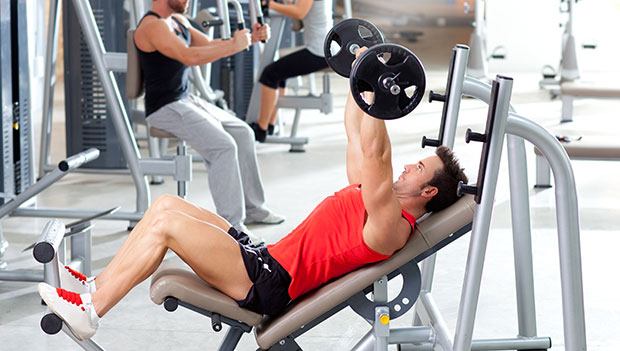
How to Build Muscle | Muscle-Building Nutrition | Muscle-Building Supplements | Hypertrophy Training | Strength Training | Chest Workouts | Back Workouts | Arm Workouts | Shoulder Workouts | Leg Workouts
When it comes to building muscle, there are very few training methodologies as effective as hypertrophy training. In reality, you can develop muscle in a top-secret D1 sports facility or by simply lugging your groceries up a five-story walkup. The issue is that most of us can't dedicate hours a day to lifting weights in the gym, nor will basic tasks lead to significant gains.
We must approach muscle building strategically to balance family, career, and busy schedules. This is where hypertrophy training comes in. If your goal is to build muscle mass in a systematic, measurable, and efficient way. Let's take a closer look at how this training can make that happen.
What is Hypertrophy Training?
The primary goal of hypertrophy training is to build muscle by increasing the diameter of muscle fibers. Growth through hypertrophy increases muscle mass, volume, size, and cross-sectional area.
While it's a favorite of bodybuilders and aesthetic lifters, don't assume this exercise is geared only towards these groups. Hypertrophy training isn't just for individuals that need to look good. It serves a host of functional purposes in both life and athletic performance.
Is Hypertrophy Better than Strength Training?
Like anything, one type of exercise may not be right for everybody. The best form of training comes down to your goals and how you want to prioritize them. Hypertrophy emphasizes muscle growth more than strength gains (your ability to exert force).
Keep in mind that there is an overlap between these two training approaches. You will get stronger with hypertrophy training and increase muscle mass with strength training. It all comes down to your primary desired outcome. With that said, if you want to build muscle, hypertrophy training is the superior option.
Types of Hypertrophy
Two kinds of hypertrophy take place within the muscle fibers of your body. Each one achieves growth by affecting different portions of your muscles.
Sarcoplasmic Hypertrophy
Sarcoplasm is the fluid around muscle cells. That fluid changes in size based on lactic acid tolerance. It's sometimes referred to as “bodybuilding hypertrophy” because growing sarcoplasm is largely activated by the higher rep schemes found in bodybuilding.
Myofibrillar Hypertrophy
Often seen as the more strength-oriented, sport-focused of the two, myofibrillar hypertrophy occurs when the actual muscle fibers become thicker and stronger. Traditionally more difficult to sustain than its sarcoplasmic partner, it is the form of hypertrophy that many powerlifters and explosive athletes tend to prioritize.
How Sarcoplasmic and Myofibrillar Hypertrophy Build Muscle
To help give you a clearer idea of what this looks like, picture a large plastic bag filled with blown-up balloons. The bag represents a cross-section of your muscle. The balloons are the myofibrils (muscle fibers), and the space between them is the sarcoplasm.
To increase the size of your plastic bag (muscle), you can either expand the space between the balloons (sarcoplasm) or increase the size of the balloons (muscle fibers).
To increase the space in your plastic bag between the balloons (sarcoplasmic hypertrophy), you will need to blow more air into the bag. For this example, you are going to be using your lungs. Filling up the plastic bag will take more breaths (reps). While each breath isn't hard to get into the bag, you will start to feel the burn due to the high number required.
Your other option is to increase the size of the balloons in your bag (myofibrillar hypertrophy). While requiring fewer breaths per balloon, your level of exertion/force to get the air into the balloon will be greater.
Both methods increase the size of your bag (muscle), but each requires a different force and volume level. The same is true regarding what form of hypertrophy you want to prioritize. How many reps to build muscle will largely depend on your desired outcomes.
How Many Reps to Build Muscle
As a general rule of thumb, sarcoplasmic-centric hypertrophy will fall within 6-12 reps at 70 percent of your one-rep max (1RM). Regarding myofibrillar hypertrophy, 6-8 reps at 75-85 percent of your one-rep max will put you in a good range.
Another important factor besides how many reps you perform is your time under tension or how long it takes you to complete the entire set. For 6-8 reps, shoot for 20-40 seconds to complete your set. Rep ranges of 6-12 should wrap up around the 60-70 second mark.
This is where getting specific about your goals becomes increasingly important. While you'll experience both forms of hypertrophy in any muscle-building workout, what movements and rep ranges you select will determine which one gets prioritized. This choice comes down to what you will use the increased muscle mass for.
Let's say, for example, that your goal was primarily aesthetic. In this situation, your priority is more about maximal muscle size and less on your ability to deadlift a heavy object. In this case, you may opt for the higher rep, lower weight sarcoplasmic hypertrophy instead of the more taxing, stress-inducing myofibrillar hypertrophy.
We'll go into specific examples of each kind of hypertrophy workout but before we do, let's look at one other important factor in implementing hypertrophy training correctly.

What Types of Movements are Best for Muscle Hypertrophy?
Not all movements are created equal when it comes to hypertrophy. It's important to avoid movements that recruit too many secondary muscles apart from your target muscle group.
Hypertrophy training is usually directed at major muscle groups like the chest, back, or posterior chain. Exercises that involve smaller assisting muscles that tire out before you reach the right rep ranges will diminish your returns significantly. The National Academy of Sports Medicine attributes this to the importance of progressive overload in achieving hypertrophy. Hitting your rep range is crucial.
The best movements will also depend on what form of hypertrophy you are trying to prioritize. Sarcoplasmic hypertrophy tends to occur more frequently when performing isolated movements.
Examples of isolated movements include:
- Seated biceps curl
- Cable triceps extension
- Machine chest press
- Machine leg press
- Machine leg extension
- Machine shoulder press
- Reverse fly
- Chest-supported bent-over row
- Dumbbell shrug
- Front raise
- One-arm front cable raise
- Seated back extension
Myofibrillar hypertrophy lends itself to more compound movements that require maximal muscle contractions to move large amounts of weight.
Examples of compound movements include:
- Barbell squat
- Deadlift
- Dumbbell lunge
- Bench press
- Lying pull-over
- Dip
- Pull-up
How Often Should I Train for Hypertrophy?
How often you train for hypertrophy largely depends on your recovery time. A common approach utilized by bodybuilders is to train each body part once a week. If you feel you can handle more, increase the volume within your training session. After three-to-four weeks of this, if your body responds well, consider increasing your training for that muscle group to twice a week.
Keep in mind there needs to be equal emphasis on your recovery as much as on the training itself. You can run the risk of diminishing returns and even injury due to overtraining if you don't take time to listen to how your body responds.
Putting it All Together
Hypertrophy is a little more nuanced than what some fitness gurus may want you to believe. At the same time, it doesn't have to be complicated or hard to implement.
A great approach would be to do the following:
- Figure out your "why" for building muscle. "I need to build muscle so I can be more explosive next season" or "I want more muscle, so I look better in my t-shirts".
- Clearly define your goals: "I want to gain 'x' amount of muscle in the following parts of my body."
- Determine which form of hypertrophy you should prioritize. You'll experience both forms regardless of which you prioritize, but this will make sure you don't do more work than is necessary for your goals.
- Schedule your training sessions with adequate space for recovery. If time is limited, consider maximizing your training time with workout splits. This allows you to alternate between opposing body parts (push vs. pull or upper vs. lower) from set to set. Another time-saving strategy is to reduce the number of isolated movements and implement more compound exercises such as deadlifts.
- Track your progress. Get on the scale, break out the tape measure, and be sure to take pictures every few weeks to assess how you are progressing.
Sample Lower-Body Hypertrophy Workout
Let's look at an example of what a well-rounded lower body hypertrophy workout would look like. Hopefully, this will help give you a good baseline as you build your own.
Deadlift
3 sets at 10-12 reps, 60-90 seconds of rest between sets
Tip: Approach the bar, positioning the middle of your feet beneath it. With your feet shoulder-width apart, engage your abs before bending your knees and lowering to lift the bar. Be sure to maintain proper spinal alignment by being conscious of raising your chest. Do not allow your body to go slack between reps. Engage your abs in order to protect your back at all times.
Lying Leg Curl

3 sets at 10-12 reps, 60-90 seconds of rest between sets
Tip: It can also be performed on a machine. With a dumbbell between your feet while laying on your stomach, engage your abs, contract your hamstrings and bring the weight straight up, careful not to extend past 90 degrees. Maintain tension throughout the movement.
Front Squat
3 sets at 10-12 reps, 60-90 seconds of rest between sets
Tip: Easiest when taken from a squat rack. Keeping the chest upright during the entire movement, lower down to just below parallel being careful not to arch your lower back.
Dumbbell Lunge

3 sets at 10-12 reps, 60-90 seconds of rest between sets
Tip: For hypertrophy, perform static lunges as opposed to walking lunges. Keep your chest upright and make sure to avoid bringing your knees over your toes.
Machine Leg Extension
3 sets at 10-12 reps, 60-90 seconds of rest between sets
Tip: Keep tension throughout the movement during the entire set. Try to avoid letting go at the bottom of the movement and make sure not to lock out your knees at the top.
Seated Calf Raise
3 sets at 12-15 reps, 60-90 seconds of rest between sets
Tip: Strive for maximum range of motion with full contraction at the top of the movement on each rep.
Get Started with Hypertrophy Training
Hypertrophy training remains one of the most well-researched, documented muscle-building methodologies. If you want to add muscle mass to your frame, consider giving hypertrophy training a long hard look. It could be what you need to take your fitness to the next level and reach your wellness goals.
How to Build Muscle | Muscle-Building Nutrition | Muscle-Building Supplements | Hypertrophy Training | Strength Training | Chest Workouts | Back Workouts | Arm Workouts | Shoulder Workouts | Leg Workouts
About the Author

David Fang started his career by studying medicine at the State University of New York. Today, he works as a competitive CrossFit athlete, Olympic lifter, and fitness consultant who knows that the key to peak performance starts with rock-solid mental resilience and psychology. David has worked with coaches and athletes from the University of Louisville and Duke University to aid in building a powerful mind-body connection.
Get ACTIVE on the Go


Couch to 5K®
The best way to get new runners off the couch and across the finish line of their first 5K.
Available for iOS | Android







Discuss This Article